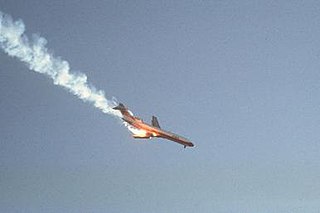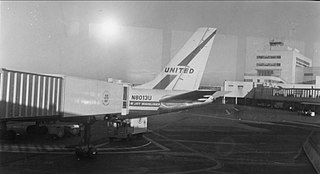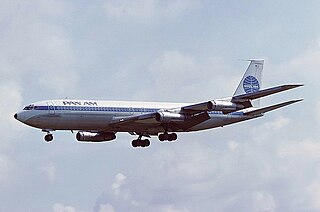
The Tenerife airport disaster occurred on March 27, 1977, when two Boeing 747 passenger jets collided on the runway at Los Rodeos Airport on the Spanish island of Tenerife. The collision occurred when KLM Flight 4805 initiated its takeoff run while Pan Am Flight 1736 was still on the runway. The impact and resulting fire killed everyone on board KLM 4805 and most of the occupants of Pan Am 1736, with only 61 survivors in the front section of the aircraft. With 583 fatalities, the disaster is the deadliest accident in aviation history.

Pacific Southwest Airlines Flight 182 was a scheduled flight of Pacific Southwest Airlines (PSA) from Sacramento to Los Angeles and San Diego. On September 25, 1978, the Boeing 727-214 serving the flight, registration N533PS, collided with a private Cessna 172 light aircraft, registration N7711G, over San Diego, California. It was Pacific Southwest Airlines' first fatal accident, and it remains the deadliest air disaster in California history. At the time, it was the deadliest air crash in American history, and remained so until American Airlines Flight 191 in May 1979.

On December 16, 1960, a United Airlines Douglas DC-8 bound for Idlewild Airport in New York City collided in midair with a TWA Lockheed L-1049 Super Constellation descending toward LaGuardia Airport. The Constellation crashed on Miller Field in Staten Island and the DC-8 in Park Slope, Brooklyn, killing all 128 aboard the two aircraft and six people on the ground. The accident was the world's deadliest aviation disaster at the time, and remains the deadliest accident in the history of United Airlines.

Air China Flight 129 (CCA129/CA129) was a scheduled international passenger flight, operated by Air China, from Beijing Capital International Airport to Gimhae International Airport in Busan. On April 15, 2002, the aircraft on this route, a Boeing 767-200ER, crashed into a hill near the airport, killing 129 of the 166 people on board.

Qantas Flight 1 was a Qantas passenger flight between Sydney and London that was involved in a runway overrun accident at Don Mueang International Airport in Bangkok on 23 September 1999 as it was landing for a stopover.

American Airlines Flight 383 was a nonstop flight from New York City to Cincinnati on November 8, 1965. The aircraft was a Boeing 727, with 57 passengers, and 5 crew on board. The aircraft crashed on final approach to the Cincinnati/Northern Kentucky International Airport located in Hebron, Kentucky, United States. Only three passengers and one flight attendant survived the crash.

Trans World Airlines (TWA) Flight 159 was a regularly scheduled passenger flight from New York City to Los Angeles, California, with a stopover in Cincinnati/Northern Kentucky International Airport, Kentucky, that crashed after an aborted takeoff from Cincinnati on November 6, 1967. The Boeing 707 attempted to abort takeoff when the copilot became concerned that the aircraft had collided with a disabled DC-9 on the runway. The aircraft overran the runway, struck an embankment and caught fire. One passenger died as a result of the accident.
The article describes accidents and incidents on Korean Air and its predecessor companies Korean National Airlines and KAL.

The Grand Canyon mid-air collision occurred in the western United States on Saturday, June 30, 1956, when a United Airlines Douglas DC-7 struck a Trans World Airlines Lockheed L-1049 Super Constellation over Grand Canyon National Park, Arizona. The first one fell into a canyon and the other one slammed into a rock face. All 128 on board both airplanes perished, making it the first commercial airline incident to exceed one hundred fatalities. The airplanes had departed Los Angeles International Airport minutes apart for Chicago and Kansas City, respectively. The collision took place in uncontrolled airspace, where it was the pilots' responsibility to maintain separation. This highlighted the antiquated state of air traffic control, which became the focus of major aviation reforms.

On June 9, 1996, while operating a passenger flight from Trenton, New Jersey to Richmond, Virginia, the crew of Eastwind Airlines Flight 517 temporarily lost control of their Boeing 737-200 because of a rudder malfunction. The crew were able to regain control and land the aircraft successfully. One flight attendant was injured.

Pan Am Flight 806 was an international scheduled flight from Auckland, New Zealand, to Los Angeles, California, with intermediate stops at Pago Pago, American Samoa and Honolulu, Hawaii. On January 30, 1974, the Boeing 707 Clipper Radiant crashed on approach to Pago Pago International Airport, killing 87 passengers and ten crew members.
Several aviation incidents and accidents have occurred in which the control surfaces of an aircraft became disabled, often due to failure of hydraulic systems or the flight control system. Other incidents have occurred where controls were not functioning correctly prior to take-off, either due to maintenance or pilot error, and controls can become inoperative from extreme weather conditions. Aircraft are not designed to be flown in such circumstances; however, a small number of pilots have had some success in flying and landing aircraft with disabled controls.











